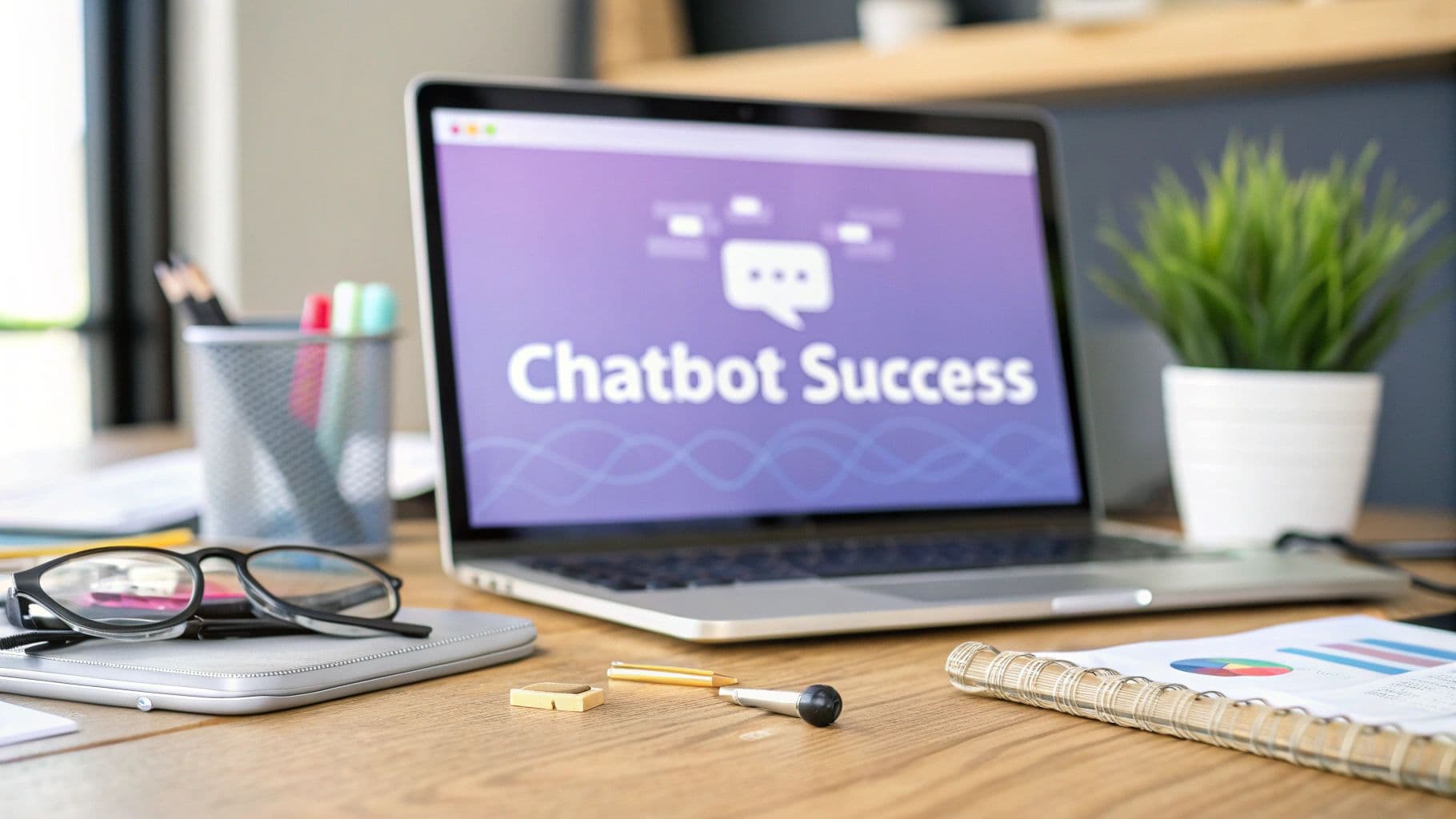The Chatbot Revolution: Why Now Is The Time
Businesses are quickly integrating chatbots, changing how they connect with customers and manage internal operations. This isn't a passing fad; it's a significant shift driven by evolving customer expectations and advancements in artificial intelligence (AI). Today's customers want immediate, personalized service around the clock. Chatbots offer a strong solution, providing instant support and simplifying interactions across various channels. This improved accessibility leads to greater customer satisfaction and better overall engagement.
The Business Case For Chatbots
Beyond meeting customer expectations, chatbots provide tangible business benefits. These automated assistants handle routine questions effectively, allowing human agents to address complex issues and strategic tasks. This division of labor boosts efficiency and reduces operational costs. Plus, chatbots collect valuable data on customer preferences and pain points, giving businesses actionable insights for product and service improvements.

The infographic above highlights key data points: Business Adoption Rate, Average Customer Service Cost Reduction, and Projected Chatbot Market Size by 2025. Chatbot adoption is increasing, with a 55% business adoption rate. This growth is fueled by significant cost savings in customer service, averaging 30%.
Chatbot Market Growth and Projections
The projected market size of $1.4 billion by 2025 underscores the growing importance of chatbots as essential business tools. This data clearly shows the compelling reasons behind the current focus on chatbots. The increasing adoption rate, along with substantial cost savings and a growing market, highlights the significant impact of chatbots on businesses.
In 2019, the global chatbot market was valued at $396.2 million. However, it's predicted to reach $9.56 billion by 2025 and an impressive $27.3 billion by 2030. Find more detailed statistics here This rapid growth is driven by progress in AI and machine learning, making chatbots more intelligent and capable.
From Basic To Intelligent: The Evolution Of Chatbots
Early chatbots used simple rule-based systems, resulting in limited functionality and often frustrating users with inflexible responses. However, advances in Natural Language Processing (NLP) and machine learning have changed chatbots into sophisticated conversational tools. These intelligent chatbots understand nuanced language, learn from past interactions, and provide personalized, context-aware responses. Implementing a chatbot today provides a significantly different and more effective solution than just a few years ago. Their ability to understand and respond to complex inquiries, and even anticipate user needs, makes modern chatbots invaluable for businesses looking to improve customer engagement and streamline operations.
Crafting Your Chatbot Strategy That Actually Works
Implementing a chatbot successfully isn't about immediately diving into platforms or code. It's about strategy. Begin by clearly identifying the business problems you want your chatbot to solve. A thorough needs assessment is key. Where will a chatbot bring the most value?
Think about whether you're looking to decrease customer support wait times, improve lead qualification, or perhaps automate order processing. Focusing on specific challenges allows you to tailor your chatbot implementation for maximum effectiveness.
Defining Clear Objectives and KPIs
After identifying the challenges, define measurable Key Performance Indicators (KPIs) that align with your business goals. These KPIs will track the chatbot’s success and demonstrate its return on investment.
For example, if your goal is to reduce support costs, a relevant KPI could be the percentage of customer inquiries resolved without human intervention. If your goal is boosting sales, track the number of leads generated or products sold through the chatbot. For more advanced tactics, explore our lead generation chatbot. Want to learn more about automating customer support? Check out this helpful article: How to master customer support automation. This kind of strategic thinking is crucial for a successful chatbot implementation.
Understanding Your Users and Prioritizing Use Cases
Developing detailed user personas is also vital. Consider the demographics, needs, and communication styles of your audience. This understanding informs the chatbot's conversational design and ensures it resonates with your users.
Prioritize use cases based on their potential business impact, not just what's technically feasible. Start with simpler implementations that offer quick wins and gradually build towards more complex functionalities. This phased approach allows for a faster return on investment and provides valuable insights for future development.
Building Stakeholder Alignment and Setting Realistic Expectations
Finally, secure buy-in from everyone involved, including customer service, marketing, and IT. Clear communication about the chatbot’s purpose, capabilities, and limitations is essential. It's also important to set realistic expectations.
A chatbot isn't an instant fix-all. Think of it as a powerful tool that, when implemented strategically, can significantly improve the customer experience and streamline operations. This realistic approach helps manage expectations and builds a collaborative environment for ongoing improvement.
To illustrate common objectives for chatbot implementation, take a look at the table below:
Common Chatbot Implementation Objectives This table outlines the primary business objectives when implementing a chatbot, along with expected outcomes and appropriate metrics for measuring success.
| Business Objective | Expected Outcomes | Key Performance Indicators |
|---|---|---|
| Reduce Customer Support Costs | Fewer human agents required, faster resolution times | Percentage of inquiries resolved by chatbot, Customer satisfaction (CSAT) scores |
| Improve Lead Generation | Increased lead capture, qualification, and nurturing | Number of leads generated, Lead conversion rate |
| Automate Order Processing | Streamlined ordering, reduced errors, faster fulfillment | Order processing time, Order accuracy rate |
The table highlights the connection between business goals, desired outcomes, and the metrics used to track success. Choosing the right KPIs allows you to monitor progress and demonstrate the value of your chatbot implementation.

By focusing on these key areas–strategy, planning, and clear communication–you can ensure your chatbot initiative delivers real value and contributes to your overall business success.
Choosing the Right Chatbot Technology (Without Regrets)
Selecting the right chatbot technology is crucial for successful implementation. With numerous options available, it's important to look beyond marketing hype and focus on your specific business needs. This involves understanding the different types of chatbots, their capabilities, and how well they align with your objectives. Making the wrong choice can lead to wasted resources and a chatbot that underperforms. This means understanding the core differences between primary chatbot types.
Rule-Based vs. AI-Powered Chatbots: Which One Do You Need?
Rule-based chatbots, also known as decision-tree bots, operate on predefined rules and scripts. Think of them as following a flowchart. They excel at handling simple, frequently asked questions and can guide users through predetermined conversational paths. However, they struggle with complex or nuanced language and don't learn from past interactions.
AI-powered chatbots, conversely, utilize Natural Language Processing (NLP) and Machine Learning (ML). This allows them to understand and respond to more complex queries, learn from user interactions, and even personalize the conversation. While more advanced, implementing AI-powered chatbots often requires more technical expertise and ongoing training.
Choosing between the two depends on factors like your budget, technical capabilities, and the complexity of the tasks you want your chatbot to handle. For a simple FAQ bot, a rule-based system might suffice. However, for more complex customer service interactions or personalized experiences, AI is the better choice. Chatbots are changing customer service and engagement, with AI projected to handle 95% of all customer interactions by 2025. Explore this topic further.
Key Considerations When Evaluating Chatbot Platforms
Beyond the core technology, evaluating chatbot platforms involves assessing several critical factors. Natural language capabilities determine how well a chatbot understands and responds to user input. Integration requirements assess how easily the chatbot integrates with your existing systems, such as your CRM or e-commerce platform. The total cost of ownership considers not just the upfront cost, but also ongoing maintenance, training, and potential upgrades.
Additionally, consider the scalability of the platform. Can it handle increasing traffic and complexity as your business grows? Security is paramount. Ensure the platform adheres to industry best practices for data privacy and protection. Finally, evaluate the vendor's reputation and support offerings. Are they reliable and responsive?
For a comprehensive comparison and to explore a powerful ManyChat alternative, check out our detailed guide. For insights into Intercom's pricing model when comparing bot platforms, see our Intercom chatbot pricing guide.
To help you compare different platforms, we've compiled the following table:
Chatbot Platform Comparison
A detailed comparison of leading chatbot platforms based on key features, pricing models, integration capabilities, and ideal use cases.
| Platform | Type | Key Features | Integration Options | Pricing Model | Best For |
|---|---|---|---|---|---|
| Dialogflow | AI-Powered | NLP, intent recognition, fulfillment | Various, including CRM and messaging platforms | Pay-as-you-go | Complex conversational experiences |
| Chatfuel | Rule-Based/AI-Powered | Visual flow builder, pre-built templates | Integrates with Facebook Messenger | Free and paid plans | Simple chatbots and Facebook marketing |
| ManyChat | Rule-Based/AI-Powered | Marketing automation, e-commerce integrations | Integrates with Facebook Messenger, Instagram, SMS | Free and paid plans | Marketing and sales automation |
This table provides a starting point for your research. Be sure to investigate each platform further to determine the best fit for your specific needs.
Build vs. Buy: Weighing the Pros and Cons
You can build a chatbot from scratch or buy a pre-built platform. Building offers maximum customization but requires significant technical expertise and ongoing maintenance. Buying a platform is generally faster and less expensive, but customization options might be limited. The best approach depends on your specific needs and resources.
Building your own chatbot necessitates a skilled development team and significant time investment. However, it offers complete control over the functionality and integration. Buying a platform is usually faster and requires less technical expertise. However, you might be limited by the platform's features and customization options.
Future-Proofing Your Chatbot Investment: A Look Ahead
The field of conversational AI is constantly evolving. To future-proof your investment, choose a platform that allows for continuous improvement and adaptation. Consider platforms that offer easy integration with emerging technologies such as voice recognition and sentiment analysis. This forward-thinking approach ensures your chatbot remains relevant and valuable as technology advances.

By carefully considering these factors, you can choose the chatbot technology that best aligns with your business goals and sets you up for long-term success. Implementing a chatbot strategically allows you to enhance customer experience, streamline operations, and gain a competitive edge. Choosing the right technology is the first crucial step in this journey.
Designing Conversations That Don't Frustrate Users
The difference between a beloved chatbot and one that's quickly abandoned often comes down to conversation design. This means crafting dialogues that feel natural, yet effectively guide users towards the help they need. A well-designed bot should feel less like talking to a machine and more like a helpful conversation.
Creating a Conversational Flow
Mapping out conversation flows is crucial. This involves anticipating user needs and planning the chatbot’s responses. Think of it like a choose-your-own-adventure story. Each user choice leads down a different path. This careful planning ensures the chatbot can handle a variety of scenarios and provide the right information. When choosing a chatbot platform, consider industry-specific applications. For example, AI Chatbots for Ecommerce can help tailor your chatbot to your business needs.
Setting Expectations With Welcome Messages
First impressions matter. A well-crafted welcome message sets the tone for the entire interaction. It should clearly explain the chatbot’s purpose and capabilities, managing user expectations right from the start. A welcome message might say, "Hi there! I can help you with order tracking and returns. What can I do for you today?" This immediately tells the user what the chatbot can and cannot do.
Designing Effective Fallback Responses
No chatbot is perfect. There will be times when it doesn't understand a user's request. Fallback responses, also known as error messages, are essential for handling these situations gracefully. Instead of just saying "I don't understand," a well-designed fallback response might suggest alternative phrasing or offer to connect the user with a human representative. This maintains user trust and prevents frustration. A good example might be: "I'm still learning. Could you rephrase your question? Or, if you prefer, I can connect you with a live agent."
Balancing Personality and Efficiency
Adding personality to a chatbot can increase engagement, but it’s important to balance that with efficiency. Users primarily want quick solutions, not extended chitchat. The chatbot’s personality should reflect your brand voice without being overly intrusive. Too much personality can quickly become annoying.
Avoiding Conversation Dead-Ends
A common frustration is hitting a conversational dead-end. This happens when the chatbot fails to provide helpful options or guidance, leaving the user stranded. Make sure every interaction offers clear next steps or alternative paths, preventing users from feeling lost. Think of it like providing signposts throughout the conversation.
Testing and Refining Dialogue Flows
Before launching your chatbot, test its dialogue flows with real users. This helps identify any unforeseen issues or areas for improvement. Gather feedback and refine the conversations based on real-world interactions. Consider this a dress rehearsal before launch, allowing you to iron out wrinkles and ensure a smooth user experience. Implementing a chatbot involves more than just technical setup. It requires understanding user needs and a commitment to continuous improvement. By focusing on these aspects of conversation design, you can create a chatbot that provides a positive and effective user experience.

Implementing Your Chatbot: From Concept to Launch
Transitioning from planning to implementation means tackling technical challenges while ensuring a smooth user experience. Consider starting with a free AI chatbot to familiarize yourself with essential features and streamline your initial deployment. For a deeper dive into specific implementation scenarios, explore our chatbot use cases. This guide offers practical steps to bring your chatbot to life across different platforms.
Integration With Existing Systems
Integrating your chatbot with existing systems is crucial. This could involve your Customer Relationship Management (CRM) platform, internal knowledge base, or even your order management system. Seamless data flow between these systems is key for your chatbot to operate effectively.
For instance, if a customer inquires about their order, the chatbot needs access to your order management system to provide accurate details. This integration needs to be secure, protecting sensitive data and preventing vulnerabilities.
Implementing Across Different Channels
Your chatbot might reside on your website, within a mobile app, or on messaging platforms like WhatsApp chatbot best practices or Facebook Messenger. Each environment has its own technical requirements.
Implementing a chatbot on a website, for example, involves different coding and integration methods compared to a mobile app or messaging platform. Recognizing these differences is crucial for a successful launch.
Handling Sensitive User Information
Data security is paramount. When implementing a chatbot, particularly one handling personal or financial data, prioritize data privacy. This includes encrypting data, both in transit and at rest, and implementing strong access controls.
Complying with relevant data privacy regulations is also essential. Protecting user data builds trust and is fundamental to responsible chatbot development. Implementing analytics from the start is also vital.
Tracking and Improving Performance
Tracking metrics like user engagement, conversation completion rates, and fallback frequency helps assess chatbot performance. These insights allow for refining responses, pinpointing areas for improvement, and optimizing the user experience. You might be interested in: How to use a chatbot for lead generation.
Creating a Maintenance Plan
Launching your chatbot isn't the end. Ongoing maintenance is crucial for long-term success. This includes regularly updating the chatbot's knowledge base and refining conversational flows based on user feedback.
Addressing technical issues promptly is equally important. A solid maintenance plan ensures your chatbot performs optimally and delivers value over time.
The Business Value of Chatbots
The business value of chatbots is significant. Companies use chatbots not only to reduce costs but also to boost brand awareness, sales, lead generation, and marketing engagement. For large enterprises (with annual revenues of at least $1 billion), chatbots have driven an average revenue increase of $823 million over three years.
Adoption is particularly high among Business-to-Business (B2B) companies, with 58% of B2B enterprises using chatbots in 2024. Almost 65% of Small and Medium-sized Businesses (SMBs) using AI chatbots report increased customer satisfaction. Learn more about chatbot statistics.
The robust growth and adoption of chatbots underscore their importance as tools for business growth. A well-maintained chatbot can adapt to evolving business needs and consistently provide a positive user experience. This proactive approach maximizes your chatbot investment, ensuring it remains a valuable asset.
Training Your Chatbot to Actually Get Smarter
Launching your chatbot is just the first step. The real magic happens when users start interacting with it. This process transforms a simple question-and-answer tool into a smart, conversational assistant. It involves understanding how to gather valuable data, identify areas for improvement, and refine the bot’s responses.
Establishing Effective Feedback Loops
Gathering feedback is crucial for improvement. Implement methods for collecting both direct and indirect feedback. Direct feedback can be obtained through simple surveys after chatbot interactions, asking users to rate their satisfaction or offer specific comments.
Indirect feedback involves analyzing conversation logs. This helps identify patterns in user behavior and pinpoint areas where the chatbot struggles. Finding the right balance is key. You need enough data to make real improvements without overwhelming your team.
Identifying Conversation Breakdowns
Analyzing conversation logs reveals where conversations go wrong. Look for patterns like frequent fallback responses, repeated questions, or user expressions of frustration. These conversation breakdowns are valuable learning opportunities.
They highlight areas where the chatbot needs better training or where the conversational flow could be adjusted. For instance, if users frequently ask the same question in different ways, it might indicate the chatbot isn't recognizing variations in phrasing. You might be interested in: How to master training ChatGPT with your data.
Expanding Your Chatbot's Knowledge Base
As your chatbot interacts with users, its knowledge base needs to grow. Regularly update its information with new FAQs, product details, or company policy updates. This keeps the chatbot relevant and allows it to handle a wider range of inquiries. This continuous expansion also helps prevent conversational dead-ends where the chatbot simply doesn't know the answer.
Refining Dialogue Flows Based on User Interactions
User interactions offer valuable insights into optimizing conversational flows. Perhaps users consistently skip certain steps or find a specific point confusing. This feedback allows you to streamline the interaction, improving its efficiency and user-friendliness.
This could involve simplifying the language, providing clearer options, or even reordering steps in the conversation.
The Role of Human Oversight
While automation is the goal, human oversight remains critical, especially early on. Having human agents monitor chatbot interactions and intervene when necessary offers valuable feedback and guarantees a positive user experience. Implement an AI Chatbot for Customer Service Today for helpful tips. This approach also enables agents to handle complex or sensitive inquiries the chatbot might not be equipped for.
Implementing A/B Testing and Measuring Performance
A/B testing is a powerful method for optimizing chatbot responses. By testing different versions of responses with different user groups, you can see which phrasing or approach is most effective. Continuously measure performance against your initial KPIs, tracking metrics like resolution rates, user satisfaction, and conversation completion rates.
Training a chatbot is an ongoing process. By establishing robust feedback loops, analyzing user interactions, and refining conversational flows, you can create a chatbot that learns and improves over time. This iterative process, combined with human oversight and data-driven analysis, is key to a truly intelligent and effective chatbot.
Future-Proofing Your Chatbot Investment
Implementing a chatbot isn't a set-it-and-forget-it project. It's an ongoing investment. The field of conversational AI is constantly evolving, meaning you need to keep your chatbot relevant and effective as technology and user expectations change. Future-proofing requires a proactive approach and an understanding of emerging trends.
Staying Ahead of the Curve: Adapting to Evolving Technologies
Advancements in machine learning, natural language understanding (NLU), and voice recognition are creating new possibilities for chatbots. Improved NLU allows chatbots to understand nuanced language and better interpret user intent, leading to more accurate responses and a smoother conversational experience. Similarly, advancements in voice recognition open up opportunities for voice-activated chatbots and integration with voice assistants like Alexa.
To stay ahead, businesses should regularly evaluate new technologies and consider how they might enhance their chatbot implementations. This requires dedicating resources to research and development and adapting to change. This might involve platform upgrades, retraining your AI model, or redesigning conversational flows.
Building a Scalable Chatbot: Planning for Growth
As your business grows, so will the demands on your chatbot. A scalable chatbot is crucial for long-term success. This means choosing a platform that can handle increasing conversation volumes without performance issues. It also means designing your chatbot with scalability in mind. For example, modular design allows for easy expansion of features as your business needs evolve.
Think of it like building with Lego blocks. A modular chatbot design allows you to add or remove components without disrupting the entire structure. This flexibility is crucial for adapting to changing market conditions and user needs.
Integrating With Emerging Channels: Meeting Customers Where They Are
Customer interaction channels are constantly expanding. Today, it’s website chat, social media like Facebook Messenger, and messaging apps like WhatsApp. Tomorrow, it might be virtual or augmented reality environments. A chatbot that integrates with new channels is crucial for staying competitive. Choose a platform with flexible integration options and stay informed about emerging communication trends.
This forward-thinking approach ensures your chatbot remains accessible to your target audience, regardless of their chosen interaction platform.
From Automation to Personalization: Enhancing the Customer Experience
The future of chatbots isn't just about automating tasks; it's about personalized and predictive interactions. Use data and AI to understand user preferences, anticipate needs, and offer tailored experiences. For example, a chatbot might suggest products based on past purchases, provide personalized support based on user history, or proactively offer assistance.
This personalization requires sophisticated data analysis and integration with other systems, such as CRM platforms and marketing automation tools. However, it can significantly enhance the customer experience and drive business outcomes.
To truly future-proof your chatbot investment, focus on a flexible, scalable, and adaptable solution that can evolve alongside your business and the ever-changing world of conversational AI.
Ready to implement a chatbot that can scale with your business and adapt to future advancements? Explore FlowGent AI's powerful no-code platform to create intelligent AI agents across multiple channels and elevate your customer support experience. Discover the possibilities with FlowGent AI.

